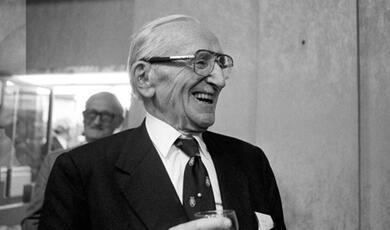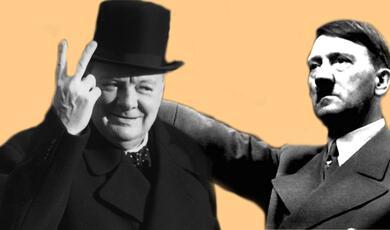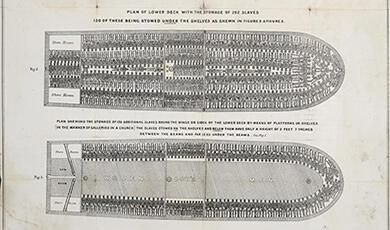Why Give? The Case for Investment in Excellent in Arts and Music
Share
- Details
- Text
- Audio
- Downloads
- Extra Reading
The Rt. Hon. The Lord Mayor, Alderman Roger Gifford, will make the case for investment in excellence in Arts and Music, building on London’s tradition of philanthropy - precursor to the important connection between commerce and community in the present day.
This is the 2013 Lord Mayor's Annual Gresham Lecture.
Download Text
21 June 2013
The Lord Mayor’s Annual Gresham Lecture:
Why Give?
The Rt. Hon The Lord Mayor Alderman Roger Gifford
Why give? Because it’s our duty? Because it’s good for us? Because society would fall apart if we didn’t?
Perhaps all of the above – but I suggest the most powerful argument for doing so is that giving to the Arts is an investment in all our interests.
Homo sum, humani nihil a me alienum puto[1]“I am human, and nothing human can be of indifference to me.” Words from 170 BC, by the Roman playwright Terentius.
Almost 2,200 years later, we continue to debate what it is that makes us human. What sets us apart. What binds together our societies – and what are the pillars of our civilisations. Because nothing human can be of indifference to us.
Friedrich Schiller wrote: “Art is the right hand of Nature. The latter has only given us being, the former has made us men.”
Arts and Music are the very definition of civilisation – and as the quantity and media of Art increases, so too do societies attain greater degrees of development. Because humanity is not existence in isolation. It is a complex web of relationships with each other, and with wider society – fostered by our own contribution, and our own reward.Arts and Music facilitate the “give and take” which is so crucial in creating a culture.
From the very origins of civilisation, humans have created, and cherished, the Arts. And in some of the most remote parts of the world, communities of ‘hunter-gatherers’ endure today.
From Paleolithic paintings of cattle in the cave site of Lascaux, France.....and Mesopotamian harps dating to 2,700 BC, excavated in the ancient city of Ur.....to Aboriginal rock art..... and the percussion and wind instruments of the indigenous people of North and South America.
Civilisations united around artistic and aesthetic traditions, which sustain something beyond the basic need for shelter and food.
Scale those examples up, to the mammoth metropolises of the western world. Yes, basic resources are essential for urban life – power, food, water, sanitation. But they do not define a civilization. They are not the core of our culture.
Nietzsche wrote: “Art is the proper task of life.”
The International Music Trust Fund, following its work with communities in the South American Andes, has said that:
“Music plays a central role as one of the performing arts that best captures the sensitivity and aspirations of communities and nations.
“Music is part of a larger social struggle towards the reinforcing of cultural identities, and of community efforts to use music as a cultural resource, thus assigning social value to music–making as an instrument of human development.”
Ladies and Gentlemen – there has been much recent debate in the media about the value of the Arts. Why we should invest. And if so, how.
Sir Thomas Gresham, founder of Gresham College – whose professors, affiliated academics, and prestigious lecture series have served the public benefit for over 400 years – knew the value of the Arts. Gresham’s seven original Professorships were: Astronomy, Divinity, Geometry, Law, Music, Physic and Rhetoric.
Sir Thomas built The Royal Exchange in the C16th, realizing the vision of his father – Lord Mayor Sir Richard Gresham – for a London rival to the Antwerp Bourse. College salaries were met by rent from shops around the Exchange..... ...bequeathed to the City Corporation and the Mercers’ Company.
Gresham’s sustained and sustainable investment not only created an Exchange to maintain and enhance the City, and UK, as the pre-eminent hub for trade and industry….but also created a College to support the edification and continued developmentof our City. This is the sort of investment where it is impossible to measure the return.
And yet the return has been priceless.
Sir Thomas, like so many of our City forebears – a phalanx of far-sighted philanthropists – was playing the long game. He knew that the City could endure and excel, only with a ready stock of informed and informative individuals..... replenishing the City’s businesses and public services with deep pool of talent.
And this is indeed the case today.
This is “Enlightened self-interest”.
Andrew Carnegie, the Scottish-American industrialist who led the expansion of the steel industry in the 19th Century, was also one of the world’s greatest philanthropists....giving $350 million to charity before his death in 1919. An astronomical sum in those days! He lived by his own ‘Carnegie Dictum’:
Spend the first third of one’s life getting all the education one can.
Spend the next third making all the money one can.
Spend the last third giving it all away to worthwhile causes.
My old Alma Mater, Oxford, was a worthwhile cause for US donors Michael Moritz and his wife Harriet Heyman – who pledged last year to give £75 million for student bursaries.... ...to honour the fact that Harriet’s mother arrived in London in 1937 as a kindertransport refugee. This is the largest gift of this kind in European history, which will support 500 undergraduates each year to study at one of the world’s best universities.
Moritz said that;
“Oxford is one of these places where if we concentrate a beam, the light will gradually dissipate to all sorts of other places in Britain.”
Moritz did not just invest in education. He invested in excellence in education.
Ladies and Gentlemen – an investment in the Arts is investment in excellence.
But how can we prove the value of the Arts? How do we apportion value on something invaluable – and define the intangible? It seems so obvious, but it is tough to make a hard investment case.
Peter Bazalgette, Chairman of the Arts Council, has made an excellent economic case for Arts in the UK – a valued by-product of investment in culture and creativity. We can encourage and enjoy great art, and improve the social wellbeing of society....whilst creating a revenue stream for arts in the future. And, as we know, the benefits generated reach far beyond the arts sector alone.
The City Corporation recently commissioned and published a ground-breaking report which showed the City’s culture sector generates £225 million and supports 6,700 jobs.
Just imagine the extent to which the Arts are a conduit for jobs and growth across the UK. Just consider the multiplier effect of the Arts on a community – the spending power of audiences in the vicinity...the wider regeneration and emergence of exciting social hubs, which we have seen on the South Bank.... Newcastle Quayside.... Edinburgh....and now Dundee – where a new V&A building will be the centrepiece of its waterfront development.
Japanese and Scottish architects are collaborating on the design – and, as a Scot who worked for many years in Japan, it is great to see such a visual representation of the strong bonds of commerce, community and creativity which exist between our countries.
The Arts and Culture sector is a catalyst for economic regeneration – revitalising local commercial creative endeavour and rebalancing economies which have experienced a decline in traditional industries.
The activity around the 2008 European ‘Capital of Culture’ – Liverpool ’08 – increased the number of creative businesses by nearly 10%. A phenomenon which also occurred at the Turner Contemporary in Margate, and the Newcastle-Gateshead cultural development project.
The Arts are also an incubator for creative talent, and have been shown to develop critical thinking and communication – which in turn improves the effectiveness and flexibility of the Nation’s workforce. Cultural institutions know and support this – through partnerships with community groups, schools and higher education.
Here in the City, our cultural organisations are a vehicle of support for our surrounding boroughs. Providing learning and volunteering opportunities, improving wellbeing and, frankly, opening eyes to a new wealth of possibilities and abilities – by increasing exposure to excellence!
Socio-cultural and constructivist research perceives learning as “fundamentally experiential and fundamentally social”, and as a process of “engaging in social practice.”[2]
Arts and Culture has a significant role to play in the experience and context of learning – as it is not just educational, but also enjoyable and stimulating creatively.
The Prince’s Foundation for Children and the Arts was founded by The Prince of Wales, after meeting students from one of the UK’s lowest-performing schools, in a deprived, depressed area of the country. One class, taught by an inspirational English teacher, was a welcome contrast. Students were showing real interest in Romeo & Juliet – but none had ever seen a professional or amateur drama performance of any kind.
The students were taken to see The Royal Shakespeare Company production of Romeo and Juliet – a life-changing experience for Every Single One. And a charity was founded which helps many more young people from low-income communities to see and enjoy the best of Arts and Music.
While the Arts are, by their very nature, elite....they are not for elite people. Art and Music, as an art-form, are a celebration of excellence. But they should be enjoyed by – and accessible to – everyone.
The principal dancers of The Royal Ballet run workshops for state schools in deprived areas – their own Billy Elliot initiative! Which is totally philanthropically funded.
The London Symphony Orchestra’s programmes enable young people from the City’s neighbouring boroughs to work with world-renowned artists – breaking down imaginary barriers of elitism, or misconceptions of excellence in music.
Guildhall Art Gallery’s ‘Youth Panel’ support the development of new exhibitions – gaining curatorial, management and marketing skills.
The Barbican offers events and classes across East London; attracting new target groups to visit and ‘improving social and emotional wellbeing’. 82% of visitors say so!
The Guildhall School of Music and Drama provides music classes in City schools and across London, and plans are afoot for a GSMD Music Therapy Centre, working with GPs and referral units.
Participation in Arts and Music has long been linked to wellbeing and ‘happiness’. Medical research – including by NICE[3], Chelsea and Westminster and the Arts Council – has shown the positive effects on certain medical conditions – particularly for elderly and vulnerable people[4].
Ladies and Gentlemen, Arts and Music permeates society at every level – and where better to observe its powerful effect than here in London, one of the most international cities in the world.....thanks to its unique cluster of services and pool of talent. A pool nourished by the City’s enduring and edifying cultural institutions.....concert halls, museums, art galleries, libraries and festivals – showcased to perfection in world-famous urban spaces.
Attraction for visitors, enrichment for residents and workers, and jobs and education for the City, its neighbouring boroughs – and indeed London as a whole.
The 2012 World Cities Culture Report says:
“London is an outward–looking city, increasingly seen as a source of creative ideas and energy. London’s excellent Art and Design schools have attracted a wave of foreign talent. Culture adds to London’s social and economic dynamism.”
London’s performing arts have forged strong international ties – through co-productions, residencies and visitors. Natural History Museum exhibitions are shown in over 65 countries. And the Barbican –today one of the world’s finest multi-arts complexes – partners Arts centres, orchestras, collections, theatres, dance companies and festivals overseas. In the 2011/12 season, 70 of the Barbican’s 95 music events showcased international artists, groups or orchestras.
This cultural exchange is an enormous plus when we are flying the flag for ‘Brand Britain’ across the globe – building commercial partnerships on foundations of friendship.
Music and Art is an important part of the UK’s international offer. The intangible, immeasurable, invaluable asset that makes Britain Great. And wherever we go in the world, we meet those eager to emulate the City’s success as a centre of excellence in the Arts.
However, at a time when the world is looking to London as a model of best practice for investment in the Arts, we must make the case for this investment.
In 2010, the Government announced a budget cut to the Department of Culture, Media and Sport – almost 300 million pounds over 4 years.[5] Arts Council England’s budget was also reduced by nearly 30% – causing them to cut funding to 206 organizations. 49 were in London.
Local authorities spend the largest amount of public money on culture – but their budgets have been cut by around 7% each year, since 2010. Not all have passed the cuts onto Arts in their communities, but Arts organizations know there is a need to update business models to accommodate diminishing public funding.
Some commentators have asserted that public funding of the Arts crowds out other sources of income – whether traded income or fundraising. However, research by Stanziola in 2011, and an imminent report by DCMS, disproves this theory.
Some suggest that private investment can entirely replace public spending on the arts, or even that “state subsidy of the arts squeezes out the great history of patronage in the arts and instead pushes the agenda of a small elite with no personal stake involved”.[6]
However, the Institute of Economic affairs has found this does not occur in practice....or tell the whole story.[7] Major donors perceive our great cultural institutions as part of the public ‘estate’ – part of the fabric of our Nation – to which the Government bears a custodial duty.
And public investment gives confidence to private investors. Funding from the HLF and ACE[8] is seen to denote project merit and sustainability – mitigating risk.
Put simply, in today’s world, we need both.
Across all cultural forms, the relationship between public and private funding is symbiotic, not substitutive.
One complements the other.
Organizations which receive the largest amount of public funding are in a stronger position to generate more traded income, and attract more philanthropic giving. The Royal Opera House, The National Museums, The Royal Shakespeare Company – to name but a few. All have the brand name, the quality of offer and the organizational capacity to lever income from a variety of sources.
The challenge is to continue inspiring investor confidence, by facilitating philanthropy alongside public funding. Philanthropy perhaps works best when it is making a targetted, innovative contribution to a specific need – complementing basic, ground-level public investment.
The City of London is a microcosm of the relationship between civic and individual support for the Arts. Each year, the Corporation contributes over £70 million to Arts, Heritage and Culture. This contribution is a very substantial catalyst for support by individual philanthropists – adding value through targetted gifts.
The word ‘philanthropy’ is taken from the Greek ‘for the love of humanity’. And from medieval to modern times, philanthropy has plugged the gap in social need. Until the last century, there was no expectation that the State would fund resources which today we would consider necessities, not luxuries. Because the necessities of today, are the luxuries of yesterday. The shortfall was met by the great men and women who assumed a personal responsibility for meeting public need.
London’s most famous Lord Mayor, Dick Whittington, left an incredible legacy. He made a fabulous fortune as a cloth merchant.....and he gave it all away. He built London’s first public lavatories, drainage systems in Cripplegate and Billingsgate, the Greyfriars library, a ward for unmarried mothers at St Thomas’s hospital, almshouses (still in use today), the Guildhall library and he repaired St Bart’s Hospital – meeting some of the exigent necessities of life for the Londoners of his day.
This was for the good of the community and the society of which he was part – some might say he would have been in deep trouble if he hadn’t put money into the community – but it was also an investment in its future. To build a better City, and enable London’s citizens to live better, healthier lives.
It was a moral choice. But it was something more as well. It was in his interests: A prosperous society is a contented society – and one that works well.
My wife Clare has retold Whittington’s story in a new children’s book – which details his philanthropy. It’s important that the younger generation learn about, and are inspired by, the example of those who went before them.
Today, we may not be tackling abject poverty....but we are tackling other poverties, like that of the mind.
The need is all around us. And it is in our own interests to meet that need. It is in our interests to build the City’s commercial success on a long-term investment in community – the two are interdependent.
And ‘enlightened self–interest’ is a mainstay of support for the Arts. A sector which has always flourished under a system of Patronage – not State funding through tax.
Commerce, Patronage and the State today forms the triangle which funds the Arts. The State is a relatively recent introduction and it is there that the relationship gets interesting...
Income Tax was only introduced in the UK at the very end of the 18th century[9], in order to pay for the war with Napoleon. The war had drained our country’s resources, and run up considerable debt. Set at 10%, the tax raised almost £6 million – and continued to contribute to the war effort until the Battle of Waterloo. At which point, Income Tax was repealed in Parliament with a “thundering peal of applause!”
However, it had been proved as a practical means of raising revenue. # A precedent had been set.
Income Tax was reintroduced in the early 19th Century to fund the railways and other National expenditure.
This was the turning point for tax.
There was a gradual increase in State responsibility for public services – and an expansion of services considered to be for the public good. Roads, railways, hospitals, schools....
As the State provision increased, so did our expectation increase. And so the balance between Patronage and State provision has changed too.
6% in 1913[10]
29% in 1939
41.2% in 1968
There were also large tax spikes after the two World Wars – causing income tax in certain circumstances to exceed 100%!
War aside, taxes began to go towards the things funded previously by far-sighted philanthropists. But taxes could never entirely replace philanthropy. Institutionalized philanthropy is a paradox – philanthropy brings personal benefit to those who give, as well as those who receive. Building a connection between the individual and society, and leaving a lasting legacy.
What is taxation but institutionalized philanthropy? And what is philanthropy but a voluntary taxation?
Last month, St Bart’s Hospital – the UK’s oldest on its original site – held its annual ‘View Day’. To this day, the Lord Mayor, Livery and other benefactors have the opportunity to visit the Hospital and see how resources are being used – and what more could be done to maximise impact.
What better demonstration of the relationship between the State and Philanthropy?
Despite the fact that St Bart’s is now funded – with other UK hospitals – by central Government....philanthropy still has an important role to play. Pioneering philanthropic support has sustained Barts through 9 centuries – such as the Whittington legacy repairs in the 15th Century. And last year’s Lord Mayor’s Appeal purchased a portable CT-scanner[11] – one of only three available in the UK.
Even at the height of the Welfare State in the 1960s, Secretary of State for Health Anthony Crossland stated his surprise at the extent to which our statutory health services depended on volunteers. While his 1976 successor, David Ennals, referred to charities as a; “£ for £ better buy in delivering services.”
Ladies and Gentlemen – philanthropic giving continues to plug the gap – and continues to make investments in areas where the Government has not assumed sole responsibility.
I referred earlier to the value of excellence in the Arts.
And Patronage and Philanthropy have long been a propelling force of Arts and Music. Philanthropy can add tremendous value, through investment in excellence.
This is the difference of an individual contribution to the Arts, versus a purely State contribution. We want a top-down, not a bottom-up approach! A ‘talent siphon’ which draws UP.
That is a tangible benefit of the Arts. By investing in excellence, we can raise the aspirations and enrichment of the community as a whole. The best of Arts and Music combats ‘poverty of the mind’.
Last month I attended the annual Christ’s Hospital School Speech Day. Founded in the City of London in the mid-16th Century with support from benefactors like the Livery Companies....which continues to this day....the school moved to Horsham in 1902. Christ’s Hospital has always offered the highest-quality education to children with real talent and potential – regardless of background.
And in Music, the School is par excellence. The foot and pitch-perfect band execute turns which would make a regimental Sergeant Major go weak at the knees! Many go on to the Guildhall School of Music and Drama and other conservatoires – having been shown, and schooled in, the very best of the Arts.
Ladies and Gentlemen, centuries of philanthropic practice and our understanding of the value of endowed capital has ensured the UK has very well-established and effective, charity and tax law – making London a global centre for managing international philanthropic funds.
And, at the very heart of philanthropy – legacy giving. There is identifiable, nation–wide capacity for greater legacy giving to the Arts.[12] The Museums Association has found that, at present, only 7% of people in the UK leave money to ANY charity when they die.[13]
Well, that’s a target to change for a start.
And I am delighted to announce that the Livery Companies of the City of London – the UK’s greatest and oldest philanthropic body – have fully endorsed a new Livery Legacy Initiative!
For hundreds of years, the Livery has protected the UK’s trades and industries by investing in the welfare and education of our communities. And the idea is that all new Liverymen and women will from now on be asked to sign a legacy form in favour of their Company’s charitable interests from their eventual estate. Many Livery Companies already have extensive legacy giving in place. So this is a reinforcement of a long-standing tradition of philanthropy. And with current inheritance tax breaks for charitable donations, it makes very good sense.
Enlightened self-interest!!
Ladies and Gentlemen – for 824 years, the Mayoralty has existed to champion the very best of Brand Britain – and to make shrewd investments in excellence for the future.
Among my 684 predecessors, were some of the UK’s greatest philanthropists....who made this City, and Nation, great. Many took pride in patronage of Art and Music – and Mansion House is a monument to their commitment. An 18th century, Grade I listed, Georgian Town Palace – it was built to impress and entertain...with the best of Music and Art. Art and Music – the stuff of civilisation are its hallmarks.
Today, it entertains 50,000 people a year – a unique forum for diplomacy and discussion. A beautiful backdrop, and an inspiration. One of its many treasures is the matchless Harold Samuel Collection of 17th Century Dutch and Flemish paintings.....left to the City by the great entrepreneur and philanthropist, Harold Samuel – the founder of Land Securities – on the condition that it was displayed at Mansion House. A new guidebook has just been produced which will enable many more people to enjoy the Collection – just some of the exceptional art in the City.
Ladies and Gentlemen – as I think you will have gathered today, I am passionate about Art and Music. I believe it can transform lives. And I am proud of the excellence and expertise of the Arts cluster here in the City.
This year’s Lord Mayor’s Charitable Appeal aims to highlight the crucial importance of this sector, in building aspiration and encouraging the next generation to strive for excellence. The primary beneficiary is a brand new charity, the City Music Foundation, which will fund performance opportunities and mentoring for musicians from all walks of life.
These are apprenticeships – supporting social mobility, building ambition and encouraging the pursuit of excellence. And this is the mind-set we want to cultivate across every career....and across every sector. As I said earlier, Art and Music ARE elite. And that is something we should prize and promote.
I believe in the elitism of excellence. And I believe that the elitism, and excellence, of Art and Music, should be available to...and should benefit....everyone.
Every community can have a top-notch orchestra. Every young person should have exposure to the best of the Arts. And every school should nurture the best artistic and musical talent in their students.
It is so important to make excellence in music, accessible. And achievable. Building aspiration in all.
The great philanthropists of the past gave where they perceived a need, in expectation of long-term, sustained benefit to the community – and indirectly, perhaps, themselves. We must have the same boldness, the same vision, to make a difference today.
So, again, why give?
Because it is an investment with tangible returns, as well as being good to do – and beneficial for the soul, no doubt. But we must give because by doing so we are also protecting our interests and those of generations to come.
Thank you.
© Alderman Roger Gifford 2013
[1]Or "I am a human being, I consider nothing that is human alien to me." From the play Heauton Timorumenos.
[2]Moussouri (2002), A context for the development of learning outcomes in museums, libraries and archives; report for Re:source
[3]http://www.nice.org.uk/niceMedia/documents/arts_mono.pdf
[4]http://www.lahf.org.uk/sites/default/files/ChelseaandWestminsterLiteratureReview/StaricoffandClift.pdf
[5]£1.4bn to £1.1bn over four years.
[6]Institute of Economic Affairs, ‘Arts Council Funding should be Cut completely’, http://www.iea.org.uk/in-the-media/press-release/arts-council-funding-should-be-cut-completely
[7]Ibid.
[8]Heritage Lottery Fund and Arts Council England
[9]Income Tax was announced in 1798, and introduced in 1799.
[10]http://www.hmrc.gov.uk/history/taxhis4.htm
[11]Computed Tomography
[12]UK Government, ‘Philanthropy in the Regions’, https://www.gov.uk/government/uploads/system/uploads/attachment_data/file/78577/philanthropy_in_the_regions.pdf
[13]Museums Association, ‘Private giving in the regions’
Part of:
This event was on Fri, 21 Jun 2013
Support Gresham
Gresham College has offered an outstanding education to the public free of charge for over 400 years. Today, Gresham College plays an important role in fostering a love of learning and a greater understanding of ourselves and the world around us. Your donation will help to widen our reach and to broaden our audience, allowing more people to benefit from a high-quality education from some of the brightest minds.


 Login
Login







